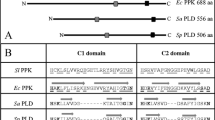Abstract
Enzymatic conversion of glycosylphosphatidylinositol (GPI)-linked Zn2+-glycerophosphocholine phosphodiesterase was investigated. The activity of glycosylphosphatidylinositol-specific phospholipase-D (GPI-PLD), based on the conversion of amphiphilic form of phosphodiesterase into hydrophilic form, showing an optimum pH of about pH 6.6, increased continuously until 60 min. The activity of membrane-bound GPI-PL, based on the formation of hydrophilic form of phosphodiesterase, exhibiting an optimum pH of 7.4, increased up to 30 min, and reached a plateau. Inhibition studies indicate that while GPI-PLD activity was generally sensitive to ionic bio-detergents, it was not inhibited by myristoyl glycerol, a neutal detergent. Meanwhile, the membrane-bound GPI-PL was not affected remarkably by these detergents except that myristoyl glycerol expressed a modest increase of activity of membrane bound GPI-PL. In addition, the membrane-bound GPI-PL appeared to be enhanced by by suramin or oleic acid, which strongly inhibited GPI-PLD. From this results, it is suggested that in brain there may be two phospholipases responsible for the conversion of membrane-bound GPI-anchors to hydrophilic forms, and that this conversion might be regulated by endogenous lipids.
Similar content being viewed by others
REFERENCES
Low, M. G. 1989. The glycosylphosphatidylinositol anchor of membrane proteins. Biochem. J. 250:865–869.
Low, M. G., and Prasad, A. R. S. 1988. A phospholipase D specific for the phosphatidylinositol anchor of cell-surface proteins is abundant in plasma. Proc. Natl. Acad. Sci. USA. 85:980–984.
Toutant, J-P., Roberts, W. L., Murray, N. R., and Rosenberry, T. L. 1989. Conversion of human erythrocyte acetylcholinesterase from an amphiphilic to a hydrophilic form by phosphatidylinositol-specific phospholipase C and serum phospholipase D. Euro. J. Biochem. 180:503–508.
Low, M. G., and Huang, K. S. 1991. Factors affecting the ability of glycosylphosphatidylinositol-specific phospholipase D to degrade the membrane anchors of cell surface proteins. Biochem. J. 279:483–493.
Davitz, M. A., Hom, J., and Schenkman, S. 1989. Purification of a glycosylphosphatidylinositol-specific phospholipase D from human plasma. J. Biol. Chem. 264:13760–13764.
Hoener, M. C., Stieger, S., and Brodbeck, U. 1990. Isolation and characterization of a phosphatidylinositol-glycan-anchor-specific phospholipase D form bovine brain. Eur. J. Biochem. 190:593–601.
Rhode, H., Eva, H. B., Schiling, K., Gehrhardt, S., Gohlert, A., Buttner, A., Bublitz, R., Cumme, G. A., and Horn, A. 1995. Glycosylphosphatidylinositol-alkaline phosphatase from calf intestine as substrate for glycosylphosphatidylinositol-specific phospholipases-microassay using hydrophobic chromatography in pipet tips. Anal. Biochem. 231:99–108.
Kominami, T., Oda, K., and Ikehara, Y. 1984. Induction of rat hepatic alkaline phosphatase and its appearance in serum: electrophoretic characterization of liver-membranous and serum-soluble forms. J. Biochem. 96:901–911.
Deng, J. T., Hoylaerts, M. F., De Broe, M. E., and Van Hoof, V. O. 1996. Hydrolysis of membrane-bound liver alkaline phosphatase by GPI-PLD requires bile salts. Am. J. Physiol. 271:655–663.
Sok, D. E., and Kim, M. R. 1993. Brain myelin-bound Zn2+-glycero—phosphocholine cholinephosphodiesterase is a glycosylphosphatidylinositol anchored enzyme of two different molecular forms. Neurochem. Res. 19:97–103.
Sok, D. E., and Kim, M. R. 1992. A spectrophotometric assay of Zn2+-glycerylphosphorylcholine phosphocholine phosphodiesterase using p-nitrophenylphosphocholine. Anal. Biochem. 203:201–205.
Low, M. G., and Huang, K. S. 1993. Phosphatidic acid, lysophosphatidic acid, and lipid A are inhibitors of glycosylphosphatidylinositol-specific phospholipase D. J. Biol. Chem. 268:8480–8490.
Burruner, G., Zalikow L., Burgess, E., Rifkin, D. B., Wilson E. L., Gruzeckakowalik, E., and Powis G. 1996. Inhibition of glycosylphosphatidylinositol (GPI) phospholipase D by suramin—like compounds. Anticancer Res. 16(5A):2513–2516.
Sok, D.-E. 1996. Properties of a Zn2+-glycerophosphocholine cholinephosphodiesterase from bovine brain membranes. Neurochem. Res. 21(10):1193–1199.
Author information
Authors and Affiliations
Rights and permissions
About this article
Cite this article
Lee, JY., Kim, M.R. & Sok, DE. Enzymatic Release of Zn2+-Glycerophosphocholine Cholinephosphodiesterase from Brain Membranes by Glycosylphosphatidylinositol-Specific Phospholipases and its Regulation. Neurochem Res 23, 899–905 (1998). https://doi.org/10.1023/A:1022419314330
Issue Date:
DOI: https://doi.org/10.1023/A:1022419314330




